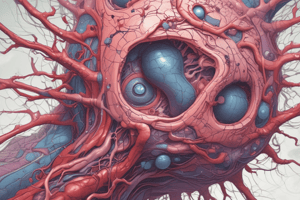Podcast
Questions and Answers
Which growth factor plays a crucial role in promoting wound healing, particularly in the proliferation phase?
Which growth factor plays a crucial role in promoting wound healing, particularly in the proliferation phase?
- Platelet-derived growth factor (PDGF) (correct)
- Transforming growth factor-alpha (TGF-α)
- Fibroblast growth factor (FGF)
- Epidermal growth factor (EGF)
What is the primary function of fibroblasts in the wound healing process?
What is the primary function of fibroblasts in the wound healing process?
- To produce antibodies against bacterial infections
- To synthesize collagen and promote wound strength (correct)
- To remove dead tissue and debris from the wound site
- To promote epithelialization and wound closure
Which of the following is a risk factor for surgical site complications?
Which of the following is a risk factor for surgical site complications?
- Regular exercise
- Healthy diet
- Young age
- Malnutrition (correct)
What is the term for the removal of dead tissue and debris from the wound site?
What is the term for the removal of dead tissue and debris from the wound site?
Which type of wound is characterized by gross infection, with pus or necrotic tissue?
Which type of wound is characterized by gross infection, with pus or necrotic tissue?
What is the primary factor influencing wound classification according to their cleanness?
What is the primary factor influencing wound classification according to their cleanness?
Which of the following is NOT a type of surgical site complication?
Which of the following is NOT a type of surgical site complication?
What is the term for the process of tissue reorganization and strengthening in the wound healing process?
What is the term for the process of tissue reorganization and strengthening in the wound healing process?
Flashcards are hidden until you start studying
Study Notes
Wound Healing Mechanisms
- Phases of wound healing:
- Inflammation (0-4 days): Hemostasis, platelet activation, and inflammation
- Debridement (4-7 days): Removal of dead tissue and debris
- Proliferation (7-14 days): Granulation tissue formation, angiogenesis, and collagen deposition
- Remodeling (14+ days): Tissue reorganization and strengthening
- Cellular and molecular mechanisms:
- Platelet-derived growth factor (PDGF) and transforming growth factor-beta (TGF-β) promote wound healing
- Fibroblasts and keratinocytes play key roles in collagen synthesis and epithelialization
Surgical Site Complications
- Types of complications:
- Infection
- Dehiscence
- Seroma
- Hematoma
- Wound necrosis
- Risk factors:
- Age
- Diabetes
- Obesity
- Smoking
- Steroid use
- Malnutrition
Wound Infection Classification
- Wound infection classification:
- Clean: No infection, no inflammation
- Clean-contaminated: Infection, but no inflammation
- Contaminated: Infection, with inflammation
- Dirty: Gross infection, with pus or necrotic tissue
Surgical Wound Classification According to Their Cleanness
- Classification system:
- Clean wounds: No break in sterile technique, no entry into hollow viscus, and no inflammation
- Clean-contaminated wounds: Break in sterile technique, but no inflammation or infection
- Contaminated wounds: Inflammation or infection, but no gross pus or necrotic tissue
- Dirty wounds: Gross infection, with pus or necrotic tissue
- Factors influencing wound classification:
- Type of surgery
- Presence of inflammation or infection
- Break in sterile technique
- Entry into hollow viscus
Wound Healing Mechanisms
- Wound healing process consists of four phases: inflammation, debridement, proliferation, and remodeling.
- Inflammation phase lasts 0-4 days and involves hemostasis, platelet activation, and inflammation.
- Debridement phase lasts 4-7 days and involves removal of dead tissue and debris.
- Proliferation phase lasts 7-14 days and involves granulation tissue formation, angiogenesis, and collagen deposition.
- Remodeling phase lasts 14+ days and involves tissue reorganization and strengthening.
- Platelet-derived growth factor (PDGF) and transforming growth factor-beta (TGF-β) promote wound healing.
- Fibroblasts play a key role in collagen synthesis, while keratinocytes play a key role in epithelialization.
Surgical Site Complications
- Infection is a type of surgical site complication.
- Dehiscence is a type of surgical site complication.
- Seroma is a type of surgical site complication.
- Hematoma is a type of surgical site complication.
- Wound necrosis is a type of surgical site complication.
- Age is a risk factor for surgical site complications.
- Diabetes is a risk factor for surgical site complications.
- Obesity is a risk factor for surgical site complications.
- Smoking is a risk factor for surgical site complications.
- Steroid use is a risk factor for surgical site complications.
- Malnutrition is a risk factor for surgical site complications.
Wound Infection Classification
- Wounds can be classified as clean, clean-contaminated, contaminated, or dirty based on the presence of infection and inflammation.
- Clean wounds have no infection and no inflammation.
- Clean-contaminated wounds have infection, but no inflammation.
- Contaminated wounds have infection and inflammation.
- Dirty wounds have gross infection, with pus or necrotic tissue.
Surgical Wound Classification According to Their Cleanness
- Surgical wounds can be classified as clean, clean-contaminated, contaminated, or dirty based on the presence of infection and inflammation.
- Clean wounds have no break in sterile technique, no entry into hollow viscus, and no inflammation.
- Clean-contaminated wounds have a break in sterile technique, but no inflammation or infection.
- Contaminated wounds have inflammation or infection, but no gross pus or necrotic tissue.
- Dirty wounds have gross infection, with pus or necrotic tissue.
- Type of surgery influences wound classification.
- Presence of inflammation or infection influences wound classification.
- Break in sterile technique influences wound classification.
- Entry into hollow viscus influences wound classification.
Studying That Suits You
Use AI to generate personalized quizzes and flashcards to suit your learning preferences.




